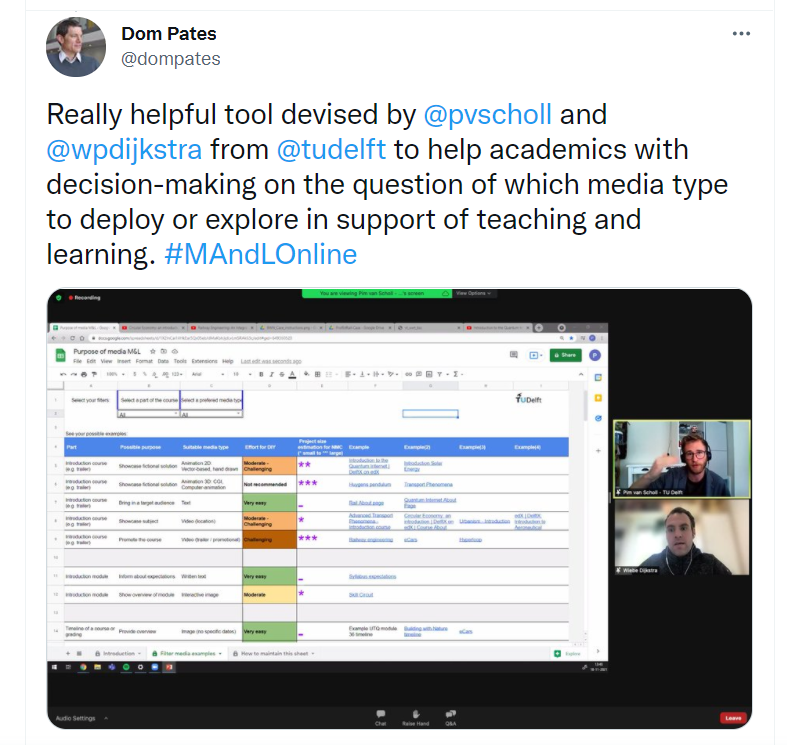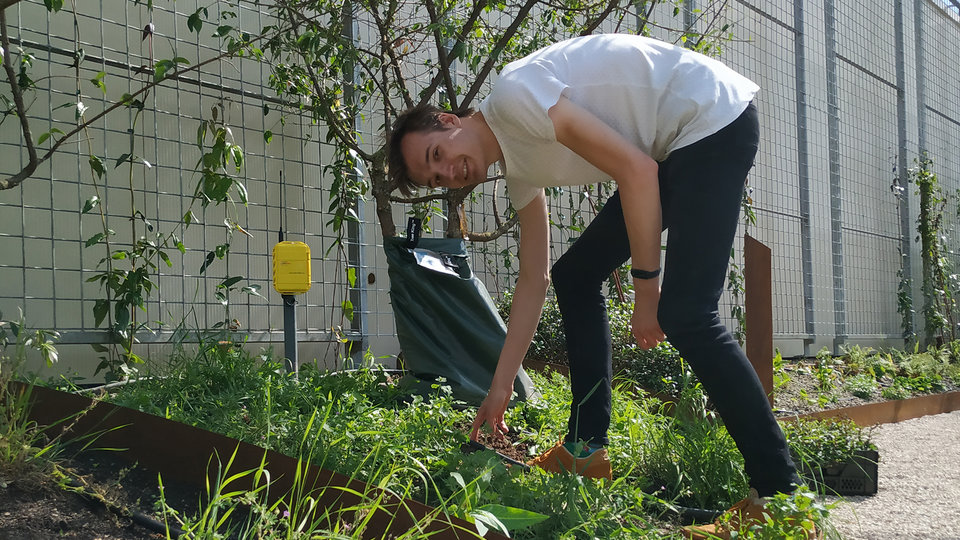More does not mean better: Consider the purpose of media in your course!
The use of video in education is rising exponentially. Although this can definitely be a good thing, it is important to make deliberate choices when selecting your format. Teaching and Learning Services (TLS) and the NewMedia Centre (NMC) worked on an overview to facilitate these choices. During the first sneak peek Pim van der Scholl and Wiebe Drijkstra discussed this overview and its possibilities during the conference 'Media & Learning Online: Autumn 2021'. During the conference, panellist and the audience called the overview “the missing link for media in education” and they believe this overview will help to inspire and inform educators on different formats. How can you benefit?
A tool to find consider media types to communicate your course content: the first prototype
A collaborative effort between TLS and NMC has resulted in an overview with various media types to help you make informed choices to tell your story. The main purpose of this document is to inspire course creators, lecturers, and education staff with over a 100 different examples of media. These examples are grouped on media type (e.g. video, text, animation etc.) or course part (introduction, content etc.). Additionally, the overview will give you an estimation of the required effort to start on such an example yourself (DIY) or to assess the effort for NMC to create it for you. The first prototype of this overview is now available as Google Sheet, you can create your own copy by using this link.
For suggestions, more information, or questions about this media-selection-tool email newmediacentre@tudelft.nl and mention the “Purpose of media – overview”.
How to use this tool
To select your media type it is important to consider the different perspectives. Let’s dive deeper into three scenario’s: 1) a content point of view, 2) the learners point of view, and 3) the lecturer’s (your) point of view.
Taking the content route
The message you want to convey with the media type should match the topic of your learning objectives. Choose a media type that does your story justice. For example, do you need a media type to describe a part of your course? Look for fitting examples by filtering on a course part and look for a matching purpose in the media-selection-tool. Explore the different media types and get inspired. Do you need to show a new environment? It makes a strong impact and thereby increases the student engagement if you demonstrate an experience through video, sound, or virtual environments, rather than explaining the concept in words. On the other hand, if you need an assignment explainer, a short text with images might be way more efficient format as a full video.
Using a learner-centric point of view
Are you curious how to make a certain piece of information stick? Use the overview to get inspired. Filter on different preferred media types like audio, 360 video or AR/VR and see what kind of needs you can fulfil by browsing the examples. To make sure the course materials are in line with what your students need, listen to your students; take course evaluations seriously and start an open conversation about their needs. This overview can help you think about individual formats, but always keep the entire course in mind: your learners don’t just watch one video, they also look at the modules before and after and do assignments that you give them. For example, making an animation might seem like an engaging piece of content, however, if that’s what they have been seeing through the entire day the animation you made may end up less engaging than you anticipated. So always look for the right balance.
Starting with your resources
As much as you’d like to take a content or learner-centric approach, sometimes it is not possible to spend much time on creating course materials or create financially heavy content. Apart from these resources, the university has a limited supply of tools and sometimes you may lack certain skills to use certain tools or media types. Understandably so, there needs to be a balance between effort and reward. Use the overview to look for this balance: does it make sense to start working on an production yourself, or do you ask the NMC for help? Use the estimations to make your own considerations, and remember: if you like it and want to invest in a specific format, enjoy it!
Contacting the right people for the right challenge
Contact the NewMedia Centre (NMC) to create media productions for your course materials by emailing to newmediacentre@tudelft.nl. For didactical or educational tooling support, the Teaching and Learning Services (TLS) can support you; email Teaching-Support@tudelft.nl. For suggestions, more information, or questions about the media-selection-tool email newmediacentre@tudelft.nl and mention “The Purpose of Media Sheet”.
Take a look at the presentation of Wiebe Dijkstra and Pim van der Scholl shared during the international Media & Learning Online: Autumn 2021 Conference!
Media Formats presentation Recording Conference
